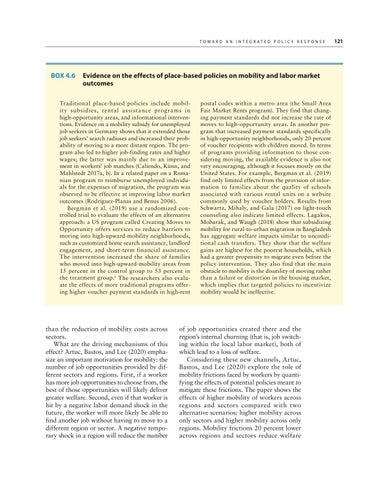T o w a r d a n I n t e g r a t e d P o l i c y R e s p o n s e
BOX 4.6 Evidence on the effects of place-based policies on mobility and labor market outcomes Traditional place-based policies include mobilit y subsidies, rental assistance prog rams in high-opportunity areas, and informational interventions. Evidence on a mobility subsidy for unemployed job seekers in Germany shows that it extended those job seekers’ search radiuses and increased their probability of moving to a more distant region. The program also led to higher job-finding rates and higher wages; the latter was mainly due to an improvement in workers’ job matches (Caliendo, Künn, and Mahlstedt 2017a, b). In a related paper on a Romanian program to reimburse unemployed individuals for the expenses of migration, the program was observed to be effective at improving labor market outcomes (Rodríguez-Planas and Benus 2006). Bergman et al. (2019) use a randomized controlled trial to evaluate the effects of an alternative approach: a US program called Creating Moves to Opportunity offers services to reduce barriers to moving into high-upward-mobility neighborhoods, such as customized home search assistance, landlord engagement, and short-term financial assistance. The intervention increased the share of families who moved into high-upward-mobility areas from 15 percent in the control group to 53 percent in the treatment group.1 The researchers also evaluate the effects of more traditional programs offering higher voucher payment standards in high-rent
than the reduction of mobility costs across sectors. What are the driving mechanisms of this effect? Artuc, Bastos, and Lee (2020) emphasize an important motivation for mobility: the number of job opportunities provided by different sectors and regions. First, if a worker has more job opportunities to choose from, the best of those opportunities will likely deliver greater welfare. Second, even if that worker is hit by a negative labor demand shock in the future, the worker will more likely be able to find another job without having to move to a different region or sector. A negative temporary shock in a region will reduce the number
postal codes within a metro area (the Small Area Fair Market Rents program). They find that changing payment standards did not increase the rate of moves to high-opportunity areas. In another program that increased payment standards specifically in high-opportunity neighborhoods, only 20 percent of voucher recipients with children moved. In terms of programs providing information to those considering moving, the available evidence is also not very encouraging, although it focuses mostly on the United States. For example, Bergman et al. (2019) find only limited effects from the provision of information to families about the quality of schools associated with various rental units on a website commonly used by voucher holders. Results from Schwartz, Mihaly, and Gala (2017) on light-touch counseling also indicate limited effects. Lagakos, Mobarak, and Waugh (2018) show that subsidizing mobility for rural-to-urban migration in Bangladesh has aggregate welfare impacts similar to unconditional cash transfers. They show that the welfare gains are highest for the poorest households, which had a greater propensity to migrate even before the policy intervention. They also find that the main obstacle to mobility is the disutility of moving rather than a failure or distortion in the housing market, which implies that targeted policies to incentivize mobility would be ineffective.
of job opportunities created there and the region’s internal churning (that is, job switching within the local labor market), both of which lead to a loss of welfare. Considering these new channels, Artuc, Bastos, and Lee (2020) explore the role of mobility frictions faced by workers by quantifying the effects of potential policies meant to mitigate these frictions. The paper shows the effects of higher mobility of workers across regions and sectors compared with two alternative scenarios: higher mobility across only sectors and higher mobility across only regions. Mobility frictions 20 percent lower across regions and sectors reduce welfare
121

